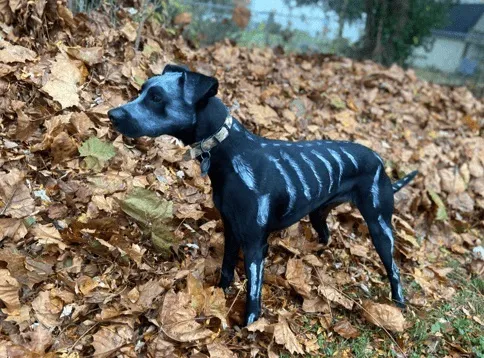Safe Halloween Costumes for Dogs
This year, Pittsburgh and Scranton are each throwing a “Howl-o-ween” event consisting of a pet parade and costume contest. Ligonier and Horsham are switching their puns out for a Halloween “Pawty”. The local scene near Harrisburg will see pet photo contests (with ice cream!) and even a “Pittie Party” at the area Humane Society, complete with no shortage of costumes. In short, everyone’s four-legged family members are getting in on the Halloween fun these days.

Dogs in costumes are, undeniably, adorable. They also give a chance for each owner to show off their own creativity and their pet’s unique personality. At the same time, recognize that dogs don’t tend to play “fancy dress” nearly as often as us humans, for good reason. Only certain clothing items, like bandanas and sweaters, tend to work well year-round as canine accessories. Strappy hats and floppy superhero capes …not so much. These items can, in fact, pose health and safety risks to your pooch without the proper levels of care.
To help prepare your pup for looking their spooky best, while still exercising proper safety precautions, keep the following 9 safety tips for dog costumes in mind:
1. Don’t Limit Movement, Sight, or Hearing
The cardinal rule of pet costumes is that they should never sacrifice an animal’s ability to basically function. If the costume inhibits movement, blocks their sight, impacts their hearing, or otherwise gets in the way of doing regular dog stuff, choose something less cumbersome.
2. Aim to Keep It Simple and Similar to Common Dog Accessories
The best Halloween costumes for dogs involve tried-and-true accessories. Think jack-o-lantern bandanas or bat-decorated collars. Themed t-shirts and sweaters are also excellent options. Anything that can primarily attach to a harness or a onesie-style pullover also tends to work well.
What all of these items have in common is that they sit on an area of the dog that’s comfortable, as opposed to an unfamiliar accessory like a hat or mask. They also do not get in the way of front or rear legs, and they support themselves nicely, meaning they aren’t as likely to flop around or slide off. These considerations are very important, especially at first when your dog is not yet used to wearing a costume.
3. Beware Straps, Strings, and Choking Hazards
Steer away from costumes that require thin straps around the neck or upper chest. In fact, any costume that has thin elastic straps or any sort of loose string should be viewed as suspect. Any of these items could become a strangulation hazard or a swallowing hazard. In a similar vein, watch out for costumes that have small components that can fall off or be pulled off, becoming a potential choking hazard.
4. Make Sure You Can Still Keep the Pet Leashed
Avoid any outfit that would make you unable to use the dog’s regular collar or harness and a leash. They will absolutely need to be leashed at any public event involving strange people and animals.
“Even the most tame, well-trained animal can get scared from all the hustle and bustle outdoors on Halloween,” said a prominent vet to PetMD. “If not on a leash, a frightened pet could easily escape, and their costume could get caught on trees, bushes or fences. Your pet may get stuck or seriously injured in the process.”
5. Keep the Weather in Mind
Planning for the weather is one of the most frustrating aspects of investing time, money, and effort in a great Halloween costume. You go through the trouble of getting your aunt to knit the perfect Gryffindor sweater, only for the weather to be 80°F on Halloween night. Or, a downpour completely soaks your hand-painted witch’s hat.
The same frustrations can ruin your best-laid plans for your pup. If the weather is hot, they shouldn’t be wearing anything too heavy or layered. Likewise, if the weather is cool, snowy, or rainy, then the animal should be somewhat protected from the elements.
Check the weather often, and have backup plans in place just in case the worst comes your way.
6. Give the Outfit a Trial Run
You want your animal to be comfortable in its costume, both physically and mentally. Start this process early, preferably 1-2 weeks before the big debut.
To start, let your dog sniff the costume and get acquainted before they don it. When you put it on, do it piece by piece. If a particular piece seems uncomfortable, see if you can get the animal used to it on its own before making them wear the whole ensemble.
Give them lots of praise and a few treats to reinforce their positive associations with the costume. Build up their comfort and confidence, and test the outfit out in real-world conditions, like a walk.
Keep an eye out for any red flags. If the costume easily shifts, for example, it could get tangled up in their legs or become a strangulation hazard. If they’re constantly pawing at their hat, see if you can get it to sit lower on the back of their head. Those who are handy with a needle or sewing machine can make some modifications, too, to improve comfort and fit.
Watch your pet closely for signs of stress. If they freeze, pant heavily, seem nervous, keep their tail tucked, or try to get out of the costume repeatedly, see if you can make adjustments or improve their sense of confidence. In the event that nothing seems to work, you may need to return the outfit and go for something less intrusive — so save those receipts!
7. Never Leave Your Animal Unattended in Their Costume
Unless the costume consists entirely of a familiar accessory, like a t-shirt or bandana, the animal should be under constant supervision while it is wearing the outfit. Owners should especially exercise caution when dogs are wearing more involved costumes with dangly bits or accessories like wigs.
8. Be Wary of Hazardous or Irritating Materials
Make sure the materials the costume is made out of are non-toxic and dog safe. When giving your outfits a trial run, look for signs of irritation or allergic reactions, including tongue swelling, watery eyes, itchiness, redness, coughing, or excessive drooling.
9. Be Prepared to Pare Down the Costume After Your First Photo Ops
Just like a child’s costume (or an adult’s during a particularly active night), pieces of the dog costume may inevitably come off as the day goes on. Don’t hesitate to get rid of the pieces that seem to be the hardest to keep on or that your dog seems to be the least comfortable with.
Keep a bag handy to place these items in so they don’t get lost, and maybe consider having a simple backup costume in the event the original causes unforeseen issues. After all, remember that your dog will likely be wearing the costume in the company of other people and animals, so their attitude and comfort level may change on the day of the costumed event.
10. Keep It Fun!
Remember the primary goal is for you and your animal to have fun. If either of you isn’t having fun, keep this in mind when you plan ahead for next year’s festivities. With a little trial and error, you and your dog can coordinate the perfect outfits without compromising comfort.
Bring Your Animal to Greenlin to Enjoy Those Human-Only Halloween Festivities
There are more great opportunities for enjoying Halloween with your dog than ever before, but people’s schedules are still packed with events and activities that aren’t quite as dog-friendly. If you’re having a party, enjoying a day at “Hersheypark In The Dark”, or otherwise doing something that may not involve the best time for your best friend, we at Greenlin are always here to lend a paw.
Our dog daycare runs daily, giving your furry family member a chance to hang out with their own species while you and the family enjoy frightening festivities. We also offer dog boarding for times when your schedule is too hectic or when the house is not as safe as a result of Halloween goings-on.
Take a look to find a Greenlin location near you and then call or click to book your pet’s appointment today!
